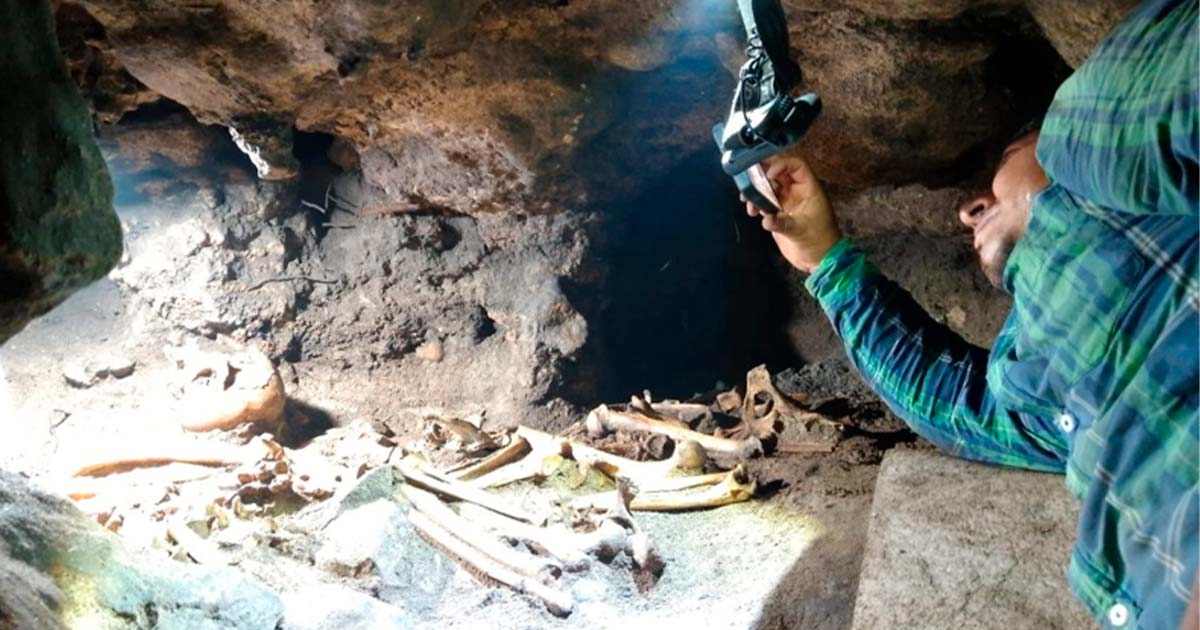Unprecedented Cave Burials Found At Tulum Open New Avenues of Investigation
A cave containing mortuary deposits of many individuals has been discovered within the walled confines of Tulum Archaeological Zone, the picturesque site of a coastal Maya city in Quintana Roo, Mexico. The find was made during the clearing of an area for a new visitor path at the archaeological site, and includes human and animal remains as well as an array of artifacts. Such a find is unprecedented, due to it being the first cave burials ever discovered there.
A Cave Burial at the Heart of Tulum Site
The cave's entrance, that was blocked by a large stone, was found between two significant structures - the Temple of the Columns (Building 21) and the Temple of Halach Uinic (Building 25) that are located at the center of the main area of the maya site, near to the dominant El Castillo temple.
Tulum is one of only a few preserved Maya sites situated on the coast of Mexico, and became prominent in the region for Maya ceremonial purposes between the 13th and 15th centuries. It was previously named ‘Zama’ meaning ‘City of Dawn’, being one of the most easterly places on the Yucatan peninsula, and so one of the first where the sun rises.
As well as being a location where priests lived, and kings had their vacation homes, it was also an important meeting place for trade, with people arriving from both sea and land to engage in commerce at the great market within the area protected by its wall.
- Tulum: Maya City of the Dawning Sun, a Caribbean Paradise
- 9,900-Year-Old Skeleton Found in Mexican Cenote Rewrites History

Ongoing excavations of the cave burials at the Tulum site in November 2023. (Gary Manners)
José Antonio Reyes Solís, who leads the archaeological research project, disclosed that a sea snail, affixed with stucco to the cave's bedrock, was discovered adorning the upper portion of the front wall, a decorative touch added by the Maya.
Upon removing the stone blocking the entrance, Reyes Solís noted that it split the remains of a human individual, leaving part of the body outside and the rest inside. Further exploration revealed two small chambers, each no more than 3 meters (10 foot) long and 2 meters (6.5 foot) wide, with an average height of 50 centimeters (1.65 foot).
Eight burials, predominantly adults, have been found in these chambers, and they are well-preserved due to the cave's favorable environmental conditions.
- Maya Warrior Queen Almost Lost in Crumbling Hieroglyphs
- An Ancient Maya City Founded by a God and Conquered by a Death Cheating Despot
The remarkable find was made as part of the efforts of the National Institute of Anthropology and History (INAH), under the Ministry of Culture's Archaeological Zone Improvement Program (Promeza). Allan Ortega Muñoz, the head of the Department of Physical Anthropology at the INAH Quintana Roo Center, is overseeing the analysis of the osteological materials.

Entrance to the cave burial site, at the burial 6 and 9 location. (Promeza research project, Tulum. Jerónimo Aviles Olguin/INAH)
An Eclectic Mix of Bones and Artifacts Discovered
A vast array of animal skeletal remains was found alongside the human burials. Preliminary identifications by project collaborators Jerónimo Avilés and Cristian Sánchez suggest these remains belong to various species, including mammals, birds, reptiles, fish, crustaceans, mollusks, and amphibians. Some bones exhibit cut marks, and others have been fashioned into artifacts typical of the region, such as punches, needles, and fan handles.
The burial site also contains numerous ceramic fragments from the Late Postclassic period (1200-1550 AD). However, only three individuals are directly associated with a small pestle and mortar, which has been restored by Carolina Segura Carrillo, a member of the conservation team at Promeza in Tulum, led by restorer Patricia Meehan Hermanson.

Burial 15 at the recent Tulum cave burial discovery. (Promeza research project, Tulum. Jerónimo Aviles Olguin/INAH)
Archaeologist Antonio Reyes Solís describes the challenges faced by the team during the excavation, including the confined space, lack of lighting, high temperature and humidity, and the presence of insects. Nevertheless, the application of new technologies like laser scanners and high-resolution photography has facilitated the preservation of the cave and its associated archaeological elements. These methods will enable the creation of detailed 3D models, allowing for continued analysis and processing of field data remotely.
Moreover, these virtual models of the archaeological context will offer the public a virtual tour of the cave's interior, showcasing the in-situ context of the archaeological materials through a digital viewer or mobile application. Field research at the site is set to continue for the remainder of the year.
Top image: Inside the cave system where the burials have been found at Tulum site. Source: Promeza research project, Tulum. Jerónimo Aviles Olguin/INAH
By Gary Manners

















